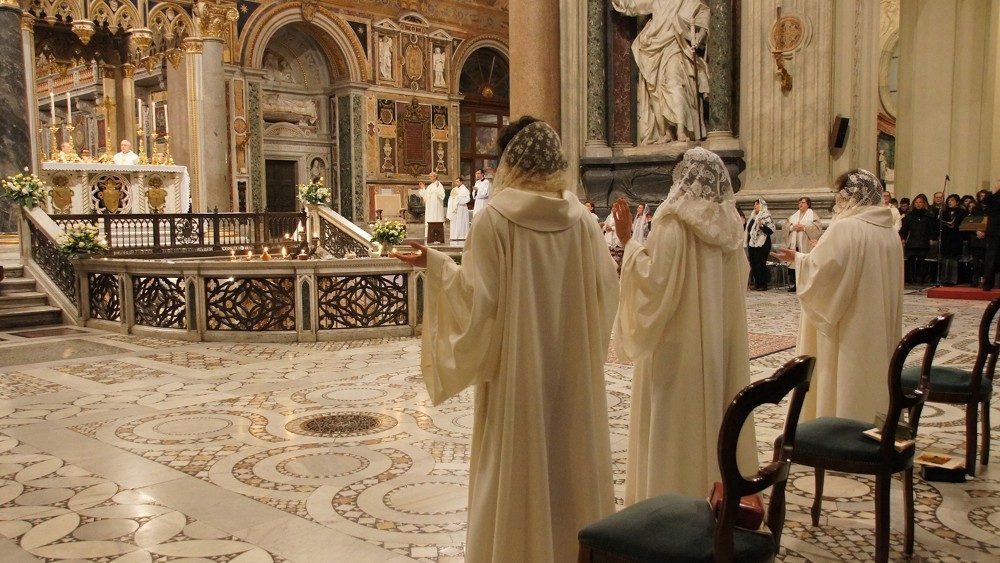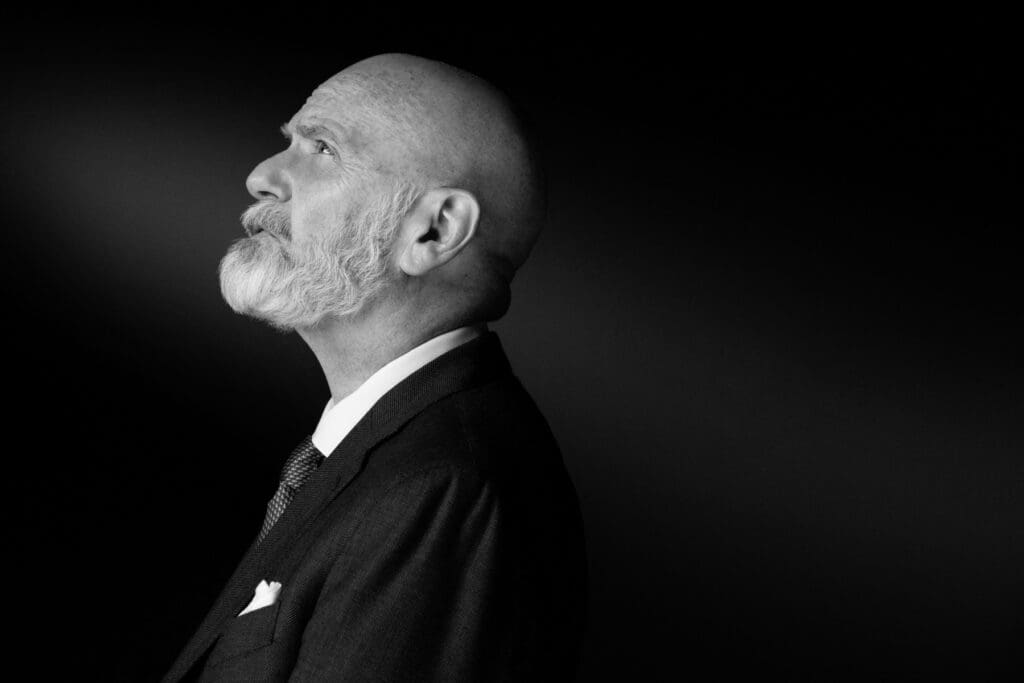INTERVIEW
First of all, what is a consecrated virgin?
Technically, I think the most bare-bones definition is a woman who’s been consecrated according to the approved liturgical rite by the diocesan bishop. That’s basically the definition that Canon 604 of the Code of Canon Law gives us.
In a more robust way, it’s a form of consecrated life among other forms of consecrated life, so it’s in the same general category as more familiar forms like religious life. As you know, there’s a big umbrella category of consecrated life that includes a variety of different forms. There’s religious life, which is life in community under a rule according to the traditions of the founder, and that includes strictly cloistered religious and active, apostolic religious. Later on, there are also societies of apostolic life, which are similar to religious but don’t make vows, per se. An example would be the Daughters of Charity or the Oratory of St. Philip Neary. Then, later, secular institutes developed whose members don’t necessarily live in community and whose vows aren’t public. That’s a very modern development.

Consecrated virginity is actually the oldest form of consecrated life.
The ritual is the defining factor, the element that divides makes someone a consecrated virgin. As a vocation there are a lot of other defining characteristics. One is literal virginity; though there can be a grey area of exactly what that means, but literal virginity for the most part is a prerequisite, so this is for never married women. Also, the entire spirituality and theological identity is living as a bride of Christ. There’s a theological sense in which you’re an image of the Church as bride. There’s a 2018 Church document on consecrated virgins titled Ecclesia Sponsae Imago, literally, “The image of the Church as bride.” In this theological sense, you become an image of the Church relating to Christ as spouse. In a more personal sense, I offer all the love I would have given to a husband and children to Christ and to the people of God in his Church.
How did you decide to become a consecrated virgin?
Personally, I felt called to live as a Bride of Christ when I was 12, and at that time, I assumed I’d become a nun or a religious of some sort. After I finished high school, I started visiting religious communities on my own. I visited several, and none of them really fit the way I felt called specifically. I had always felt more inspired by the early virgin martyrs—St. Agnes, St. Agatha, the women of the Roman Canon—than the religious founders like St. Dominic or St. Francis, though I think they are wonderful saints, too.
So when I was 19, I started to read the code of canon law and the section on consecrated life, just for my own study. I had no idea I would become a canonist back then. I saw Canon 604 and realised you could still do this: you could live like the virgin martyrs who had consecrated themselves to Christ. A priest I knew gave me a copy of the Ritual of Consecration and when I read it, I knew instantly that this was what I was called to. I was consecrated when I was 23.
Tell me about the history of this vocation. As I understand, it’s very ancient, as you said, and then somewhere along the line it disappeared, and was then restored by Vatican II.
This vocation was, as far as we know, the earliest recognised form of consecrated life. Our oldest reference to the Ordo Virginum is St. Ignatius of Antioch, who was writing sometime between 90 and 110. He greets “the ever virgins called widows in the church of Smyrnia,” and we think that was a reference to women dedicated to a life of virginity as a distinct group. By the fourth century, a ritual had developed in the Church. There’s a pious legend that the Rite was composed by St. Matthew the Evangelist. Obviously we can’t prove that, but our earliest references to this Rite are in some of the fourth-century Church Fathers’ writings. Our earliest copies of the right are from some of the earliest sacramentaries, like the 7th-century Leonine sacramentary.
In the patristic era, there were periods when there was overlap between consecrated virgins and proto-religious communities. St. Caesarius of Arles wrote a rule for consecrated virgins who were living in common. It’s a little hard to say whether that was the first religious community, or just an outgrowth of the order of virgins, but it definitely establishes an ancient pedigree for consecrated virginity in the Church. Then in the sixth century, St. Benedict’s sister St. Scholastica started living in common with other women according to a rule. That was really the beginnings of women’s religious life in the West; once that idea took root, I think culturally it supplanted the order of virgins living outside of monasteries.
From what I can tell, the first monasteries were communities of consecrated virgins. A woman became a consecrated virgin, and then she joined a monastery. But then it seems to have changed very quickly. First a woman joined a community, then she made her religious vows, and then, in a lot of women’s communities, she became a consecrated virgin on top of that. The Benedictines and the Carthusians have a tradition of that.
I don’t know too much if they still do this, but in the Carthusians a woman would make her solemn profession, and then some years later, she would become a consecrated virgin. At her consecration, she was given a maniple and a stole—liturgical garments. The thought is that this might have harkened back to deaconesses. Also, with the Carthusians, if a woman was a consecrated virgin, she could chant the gospel at Matins, part of the Liturgy of the Hours. I don’t know if that was considered a duty or a privilege or both, but anyways, there were these monastic orders where the consecration of virgins was existing as part of the monastic customs, but it wasn’t a distinct form of consecrated life.
Technically, consecrating women outside of monasteries according to the Rite of the Consecration of Virgins wasn’t forbidden until the twentieth century. From what I understand, that prohibition came about this way: within the liturgical movement of the early twentieth century, especially among the Solemn communities of Benedictines, there was an interest in reviving some ancient liturgical traditions, including the use of this ritual to consecrate woman who weren’t also nuns.
It had never been forbidden to use the ritual, but several bishops wrote to the Congregation for Religious in Rome, and in 1928 they got a definitive answer of, “No you can’t do this.”
Then, as part of the general liturgical renewal of the Second Vatican Council, the first document that came out of the council addressed this issue. Sacrosanctum Concilium stated in paragraph 80 that the rite for consecrating virgins was to be revised. When it was revised, it was revised with one rite specifically for nuns and one specifically for non-monastic women—women living in the world.
What is its significance for our time?
In a lot of ways, the restoration of the Rite of the Consecration of Virgins is similar to the restoration of the diaconate. As a side note, I think the permanent deaconate was intended to be celibate—look, for example, at St. Lawrence, who was celibate and had the vocation of deacon. Of course what happened, at least in the United States, is that the married deaconate took off. But I think at the Council, the Church was working to bring back these vocations from the early Church in Rome, which for me is very moving since it was the early virgin martyrs who inspired me.
In many ways, the Church finds itself today in a situation more like that of the early Church than it has been in a millennium or so. It might be the work of the Holy Spirit or Providence that we have these ancient vocations coming back. I do think there will always be a place for religious life in the Church. It’s an important vocation and new developments don’t supplant the old ones, but I also think that consecrated virginity, consecrated women living amid a secular and sometimes hostile culture, is an important witness. It teaches us something unique about the Church. On another side note, consecrated virgins are not akin to a secular institute, which is meant to be a hidden leaven in the world. Consecrated virgins make public promises. People should know that we are consecrated to God.
It sounds like the main characteristic of consecrated virginity is that you are consecrated by the bishop.
Yes, and set aside for God the context of a local diocesan church.
In this sense, the Ordo Virginum is a female analogue to the all-male priesthood, no?
In terms of a broader ecclesial sign value, I think there’s a lot to be said about consecrated virgins as a complement to the priesthood. This is the only form of life in the Church that’s open only to women; men can’t become consecrated virgins. So yes, there is great complementarity.
When I was discerning, I remember thinking that if I were a man I’d be a diocesan priest. I do not support woman’s ordination, but there seemed to me that there was a gap here for women. If you’re a religious, your primary bond is not with your diocese; it’s with your community or your order more broadly. It was troubling to me because there didn’t seem to be an option where a woman could be consecrated and dedicate her life of evangelical chastity to the service of God and the Church in the context of a local church. And then I realised that the vocation of consecrated virginity fills that gap. It allows me to be a woman who is consecrated to God in the context of the local church at the hands of a local diocesan bishop.
The ritual parallels the Rite for Priestly Ordination in some ways. For example, early in the ritual the bishop asks you if you are resolved to persevere to the end of your days in the holy state of virginity in the service of God and His Church; if you are so resolved to follow Christ in the spirit of the Gospel that your whole life may be a faithful witness to God’s love and a convincing sign the kingdom of heaven; and if you are resolved to accept consecration as a bride of our Lord Jesus Christ, the Son of God. It’s not a vow like religious make, though it’s a public promise. It’s an older form of commitment than a vow as such, called in Latin a positive.
In the push for woman deacons, I’ve often thought: We already have the Order of Virgins and this could really fit into what a lot of people think woman deacons would be, in as much as they are women dedicating their whole lives to serving the Church in a way that complements the male clergy.
I don’t want to reduce this to a function or say consecrated virgins are just for doing a job in the Church. The value of this vocation is who you are, who you are in relationship to the Lord. But I do feel like this could have a lot of practical benefit for the Church, and I don’t think we’ve really explored that very sufficiently at this point.
Also, Pope Francis is always talking about appreciating women while not trying to make women more like men. Since this is only open to women, the Order of Virgins is something that respects the charism of womanhood and its uniqueness. It acknowledges women as women. It acknowledges that we have distinctive feminine gifts, but it still calls women to a full development of their person. Ecclesia Sponsae Imago actually requires candidates for consecrated virginity to have theological formation and to study theology, as well as growing in human maturity.
I think the Church is trying to thread the needle between not turning women into men and not infantilizing women, and I think consecrated virginity gives us a good vision of what the uniqueness of womanhood can look like.





